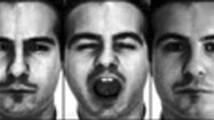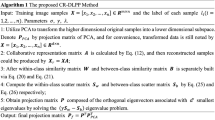Abstract
Manifold learning as an efficient dimensionality reduction method has been extensively used. However, manifold learning suffers from the problem of manual selection of parameters, which seriously affects the algorithm performance. Recently, applications of collaborative representation have received concern in some fields such as image processing and pattern recognition research. Based on manifold learning and collaborative representation, this paper develops a new algorithm for feature extraction, which is called collaborative representation-based discriminant neighborhood projections (CRDNP). In CRDNP, we first construct intra-class and inter-class neighborhood graphs of the input data as well as a weight matrix based on collaborative representation model and class label information. Then, a projection to a reduced subspace is obtained by margin maximization between the between-class neighborhood scatter and within-class neighborhood scatter. CRDNP not only characters the inherent geometry relationship of the dataset using L2-graph, but also enhances the between-class submanifold separability. In addition, the discriminating capability of CRDNP is further improved by obtaining the orthogonal projection vectors. Experiment results on public face datasets prove that CRDNP can achieve more accurate results compared with the existing related algorithms.










Similar content being viewed by others
References
Turk M, Pentland A (1991) Eigenfaces for recognition. J Cognit Neurosci 3(1):71–86
Belhumeur PN, Hespanha JP, Kriegman DJ (1997) Eigenfaces versus fisherfaces: recognition using class specific linear projection. IEEE Trans Pattern Anal Mach Intell 19(7):711–720
Ye J, Li Q (2005) A two-stage linear discriminant analysis via QR-decomposition. IEEE Trans Pattern Anal Mach Intell 27(6):929–941
Howland P, Wang J, Park H (2006) Solving the small sample size problem in face recognition using generalized discriminant analysis. Pattern Recognit 39(2):277–287
Roweis ST, Saul LK (2000) Nonlinear dimensionality reduction by locally linear embedding. Science 290(5500):2323–2326
Seung HS, Lee DD (2000) The manifold ways of perception. Science 290(5500):2268–2269
Tenenbaum JB, Desilva V, Langford JC (2000) A global geometric framework for nonlinear dimensionality reduction. Science 290(5500):2319–2323
Xiang S, Nie F, Zhang C, Zhang C (2009) Nonlinear dimensionality reduction with local spline embedding. IEEE Trans Knowl Data Eng 21(9):1285–1298
Zhang T, Li X, Tao D, Yang J (2008) Local coordinates alignment (LCA): a novel manifold learning approach. Int J Pattern Recognit Artif Intell 22(04):667–690
Zhang Z, Zha H (2004) Principal manifolds and nonlinear dimensionality reduction via tangent space alignment. SIAM J Sci Comput 26(1):313–338
Belkin M, Niyogi P (2003) Laplacian eigenmaps for dimensionality reduction and data representation. Neural Comput 15(6):1373–1396
Carreira-Perpinán MA (2010) The elastic embedding algorithm for dimensionality reduction. In: ICML, pp 167–174
Wang J, Zhang Z, Zha H (2005) Adaptive manifold learning. In: Advances in neural information processing systems, pp 1473–1480
Elhamifar E, Vidal R (2011) Sparse manifold clustering and embedding. In: Advances in neural information processing systems, pp 55–63
Zhang H, Wu QJ, Chow TW, Zhao M (2012) A two-dimensional neighborhood preserving projection for appearance-based face recognition. Pattern Recognit 45(5):1866–1876
He X, Yan S, Hu Y, Niyogi P, Zhang H-J (2005) Face recognition using laplacianfaces. IEEE Trans Pattern Anal Mach Intell 27(3):328–340
Zhang W, Xue X, Lu H, Guo Y-F (2006) Discriminant neighborhood embedding for classification. Pattern Recognit 39(11):2240–2243
Chen HT, Chang HW, Liu TL (2005) Local discriminant embedding and its variants. In: IEEE computer society conference on computer vision and pattern recognition, CVPR 2005, vol 2, IEEE, pp 846–853
Cai D, He X, Zhou K, Han J, Bao H (2007) Locality sensitive discriminant analysis. In: IJCAI, vol 2007, pp 1713–1726
Yu W, Teng X, Liu C (2006) Face recognition using discriminant locality preserving projections. Image Vis Comput 24(3):239–248
Yan S, Xu D, Zhang B, Zhang H-J, Yang Q, Lin S (2007) Graph embedding and extensions: a general framework for dimensionality reduction. IEEE Trans Pattern Anal Mach Intell 29(1):40–51
Wright J, Yang AY, Ganesh A, Sastry SS, Ma Y (2009) Robust face recognition via sparse representation. IEEE Trans Pattern Anal Mach Intell 31(2):210–227
Liu W, Chang SF (2009) Robust multi-class transductive learning with graphs, pp 381–388
Lu CY, Min H, Gui J, Zhu L, Lei YK (2013) Face recognition via weighted sparse representation. J Vis Commun Image Rep 24(2):111–116
Yang M, Zhang L (2010) Gabor feature based sparse representation for face recognition with gabor occlusion dictionary. In: Computer vision–ECCV 2010, pp 448–461
Gao S, Tsang IW, Chia LT (2010) Kernel sparse representation for image classification and face recognition. In: Computer vision–ECCV 2010, Springer, Berlin, pp 1–14
Zou H, Hastie T, Tibshirani R (2006) Sparse principal component analysis. J Comput Gr Stat 15(2):265–286
Qiao Z, Zhou L, Huang JZ (2009) Sparse linear discriminant analysis with applications to high dimensional low sample size data. IAENG Int J Appl Math 39(1):48–60
Clemmensen L, Hastie T, Witten D, Ersbøll B (2011) Sparse discriminant analysis. Technometrics 53(4):406–413
Qiao L, Chen S, Tan X (2010) Sparsity preserving projections with applications to face recognition. Pattern Recognit 43(1):331–341
Cheng B, Yang J, Yan S, Fu Y, Huang TS (2010) Learning with l1-graph for image analysis. IEEE Trans Image Process Publ IEEE Signal Process Soc 19(4):858–866
Gui J, Sun Z, Jia W, Hu R, Lei Y, Ji S (2012) Discriminant sparse neighborhood preserving embedding for face recognition. Pattern Recognit 45(8):2884–2893
Song F, Zhang D, Mei D, Guo Z (2007) A multiple maximum scatter difference discriminant criterion for facial feature extraction. IEEE Trans Syst Man Cybern Part B (Cybern) 37(6):1599–1606
Li H, Jiang T, Zhang K (2004) Efficient and robust feature extraction by maximum margin criterion. In: Advances in neural information processing systems, pp 97–104
Lai J, Jiang X (2013) Discriminative sparsity preserving embedding for face recognition. In: ICIP, pp 3695–3699
Zang F, Zhang J (2011) Discriminative learning by sparse representation for classification. Neurocomputing 74(12):2176–2183
Q. Shi, A. Eriksson, A. Van Den Hengel, and C. Shen, “Is face recognition really a compressive sensing problem?.” pp. 553-560
Shi Q, Eriksson A, Van Den Hengel A, Shen C (2011) Is face recognition really a compressive sensing problem? pp 471–478
Timofte R, Van Gool L (2014) Adaptive and weighted collaborative representations for image classification. Pattern Recognit Lett 43:127–135
Yang W, Wang Z, Yin J, Sun C, Ricanek K (2013) Image classification using kernel collaborative representation with regularized least square. Appl Math Comput 222:13–28
Peng X, Zhang L, Yi Z, Tan KK (2014) Learning locality-constrained collaborative representation for robust face recognition. Pattern Recognit 47(9):2794–2806
Yang W, Sun C, Liu Q, Ricanek K (2012) Collaborative representation based projections for face recognition. In: Chinese conference on pattern recognition, Springer, Berlin, pp 276–283
Yang W, Wang Z, Sun C (2015) A collaborative representation based projections method for feature extraction. Pattern Recognit 48(1):20–27
He X, Cai D, Yan S, Zhang H-J (2005) Neighborhood preserving embedding. In: ICCV, pp 1208–1213
Pang Y, Yu N, Li H, Zhang R, Liu Z (2005) Face recognition using neighborhood preserving projections. Adv Multimed Inf Process PCM 2005:854–864
Yin F, Jiao LC, Shang F, Xiong L, Wang X (2014) Sparse regularization discriminant analysis for face recognition. Neurocomputing 128(5):341–362
Zhang H, Ji Y, Huang W, Liu L (2018) Sitcom-star-based clothing retrieval for video advertising: a deep learning framework. Neural Comput Appl 2018:1–20
Acknowledgments
This work is supported by Foundation of Henan Educational Committee (No. 2009A520018), the Science and Technology Project of Henan Province (Nos. 142102210472, 152102210329 and 182102310041), and the Young Core Instructor of Colleges and Universities in Henan Province Funding Scheme (No. 2011GGJS-173).
Author information
Authors and Affiliations
Corresponding author
Additional information
Publisher's Note
Springer Nature remains neutral with regard to jurisdictional claims in published maps and institutional affiliations.
Rights and permissions
About this article
Cite this article
Wang, G., Shi, N. Collaborative representation-based discriminant neighborhood projections for face recognition. Neural Comput & Applic 32, 5815–5832 (2020). https://doi.org/10.1007/s00521-019-04055-6
Received:
Accepted:
Published:
Issue Date:
DOI: https://doi.org/10.1007/s00521-019-04055-6




